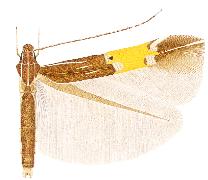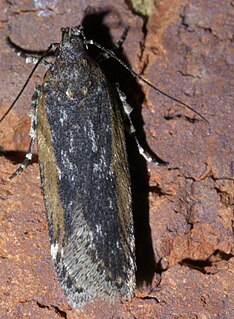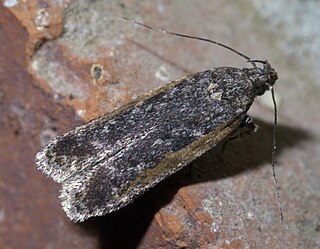
Cosmopterix clandestinella is a moth of the family Cosmopterigidae. It is known from the United States.

Cosmopterix magophila is a moth of the family Cosmopterigidae. It is known from the United States and the Dominican Republic.

Cosmopterix sinelinea is a moth of the family Cosmopterigidae. It is known from South Carolina, United States.

Cosmopterix thelxinoe is a moth of the family Cosmopterigidae. It is known from Brazil and the United States.

Pubitelphusa latifasciella, the white-banded telphusa moth, is a moth of the family Gelechiidae. It is found in North America, where it has been recorded from Alabama, Arkansas, Florida, Georgia, Illinois, Indiana, Kansas, Kentucky, Louisiana, Maryland, Minnesota, Mississippi, Missouri, New Jersey, New York, North Carolina, Ohio, Oklahoma, Ontario, Quebec, South Carolina, Tennessee, Texas, Virginia, West Virginia and Wisconsin.

Spinitibia is a genus of moths in the family Autostichidae. It contains only one species, Spinitibia hodgesi, which is found in North America, where it has been recorded from Alabama, Arkansas, Florida, Georgia, Indiana, Kansas, Louisiana, Mississippi, Oklahoma, South Carolina, Tennessee and Virginia.

Doryodes spadaria, the dull doryodes moth, is a moth of the family Erebidae. The species was first described by Achille Guenée in 1857. It is found in North America, where it has been recorded from coastal Florida, Georgia, North Carolina, South Carolina and Texas. The habitat consists of salt marshes.
Epermenia falcata is a moth in the family Epermeniidae. It was described by Reinhard Gaedike in 2008. It is found in North America, where it has been recorded from the state of Washington.
Helcystogramma melantherella is a moth in the family Gelechiidae. It was described by August Busck in 1900. It is found in North America, where it has been recorded from North Carolina south to Florida and west to Texas and Arkansas.

Chionodes pseudofondella is a moth in the family Gelechiidae. It is found in North America, where it has been recorded from New Hampshire, southern Ontario, Nebraska, Arkansas and North Carolina.

Agnippe prunifoliella is a moth in the family Gelechiidae. It is found in North America, where it has been recorded from Alabama, Alberta, Arizona, Arkansas, British Columbia, California, Florida, Illinois, Indiana, Kansas, Kentucky, Louisiana, Maine, Maryland, Mississippi, North Carolina, Oklahoma, Quebec, South Carolina, Tennessee, Texas and West Virginia.

Aroga compositella, the six-spotted aroga moth, is a moth of the family Gelechiidae. It is found in the United States, where it has been recorded from Alabama, Colorado, Florida, Georgia, Louisiana, Maine, Massachusetts, Mississippi, New Hampshire, North Carolina, Oklahoma, South Carolina, Tennessee, Texas and Wisconsin.
Coleotechnites cristatella is a moth of the family Gelechiidae. It is found in North America, where it has been recorded from Kentucky.
Coleotechnites vagatioella is a moth of the family Gelechiidae. It is found in North America, where it has been recorded from Kentucky and Texas.
Calliprora sexstrigella is a moth of the family Gelechiidae. It is found in North America, where it has been recorded from Arizona, California, New Mexico and Texas.

Filatima pseudacaciella, the dusky-backed filatima moth, is a moth of the family Gelechiidae. It is found in North America, where it has been recorded from California, Illinois, Indiana, Kansas, Kentucky, Louisiana, Maine, Massachusetts, Mississippi, New Hampshire, New York, Ohio, Oklahoma, Ontario, Tennessee and West Virginia.

Filatima serotinella is a moth of the family Gelechiidae. It is found in North America, where it has been recorded from Alabama, Alberta, Arkansas, Colorado, Illinois, Indiana, Kansas, Kentucky, Louisiana, Maine, Maryland, Mississippi, South Carolina, Tennessee, Texas and West Virginia.
Gnorimoschema ericameriae is a moth in the family Gelechiidae. It was described by Keifer in 1933. It is found in North America, where it has been recorded from California.
Taygete sylvicolella is a moth in the family Autostichidae. It was described by August Busck in 1903. It is found in North America, where it has been recorded from Illinois, Maine, New York, Ohio and South Carolina.

Eupragia hospita is a moth in the family Depressariidae. It was described by Ronald W. Hodges in 1969. It is found in North America, where it has been recorded from Florida south to South Carolina and west to Texas.









